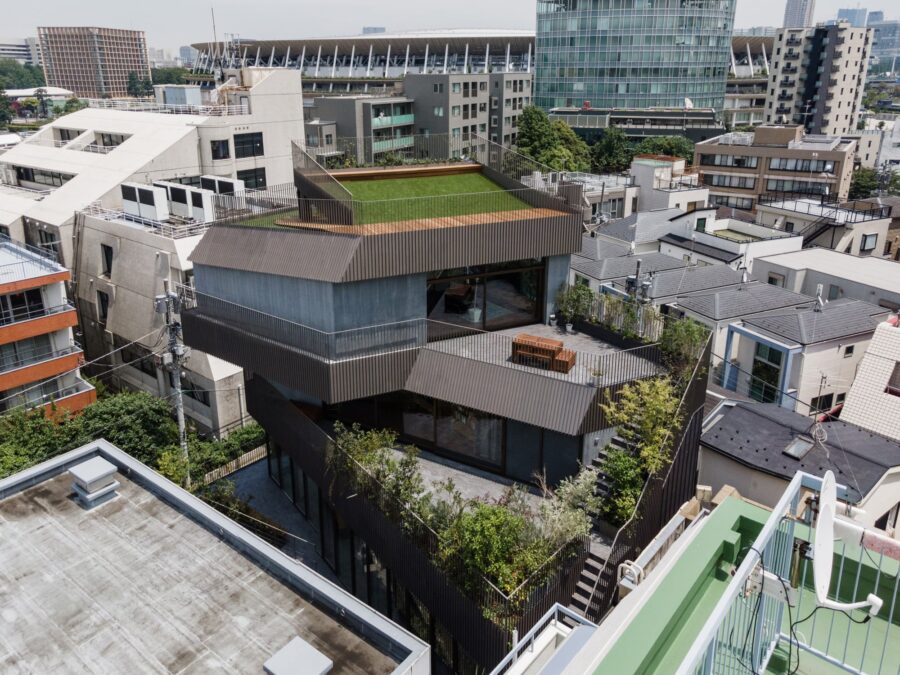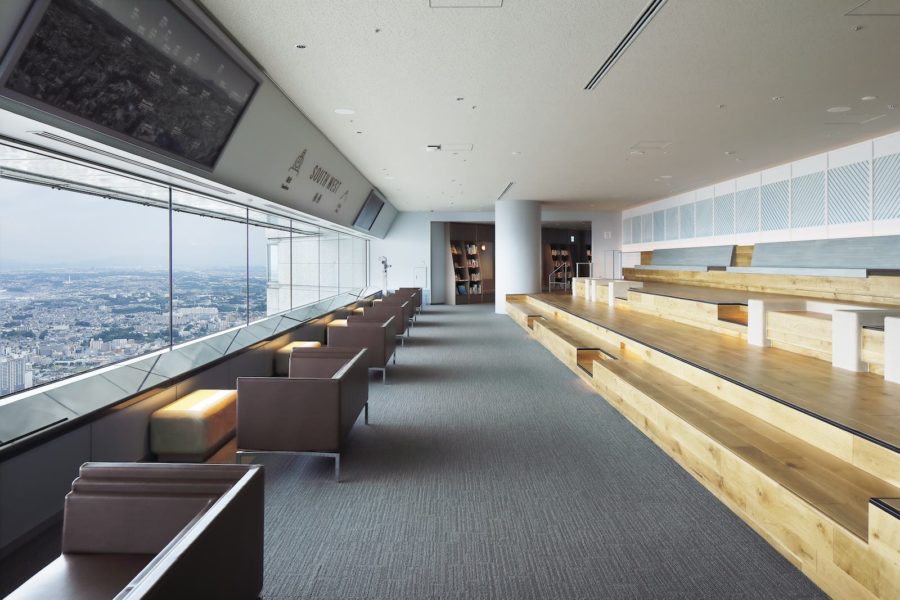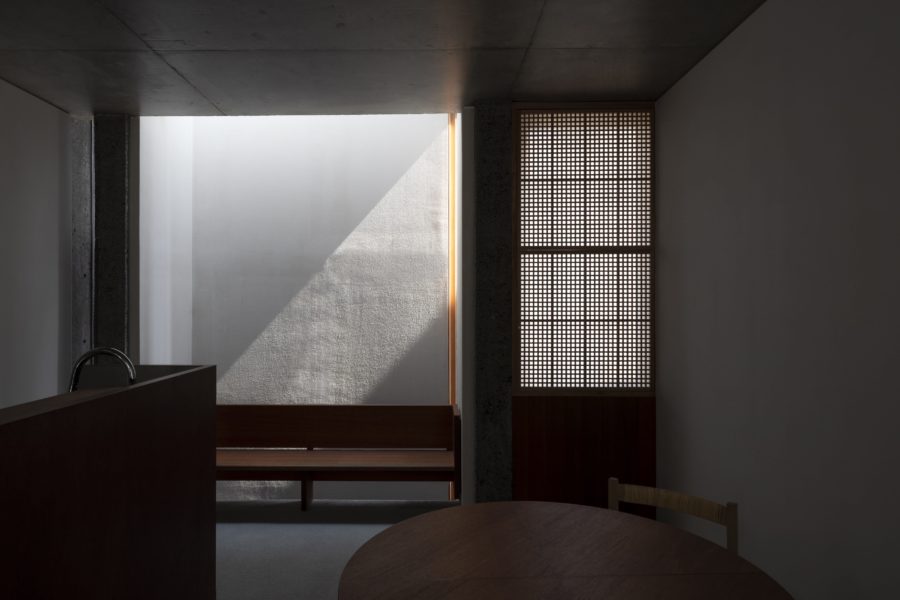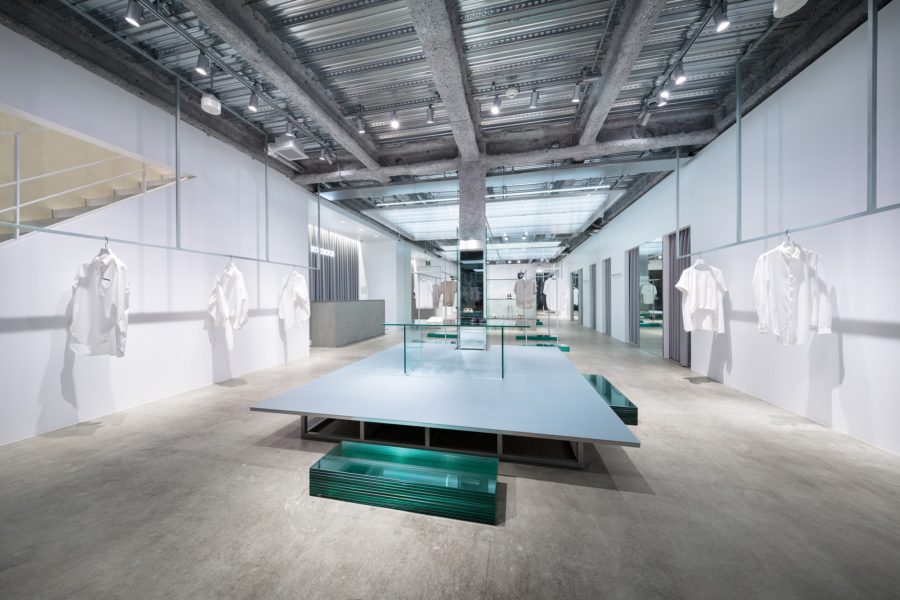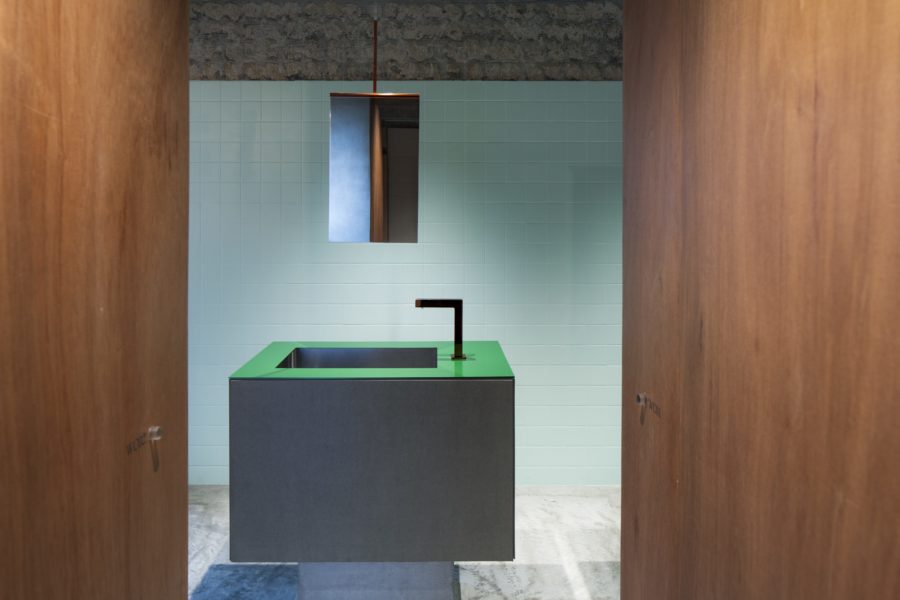1984年に広島で第1号店をオープンしたユニクロは、現在世界で2200店舗以上を展開するグローバルなアパレルブランドである。2019年、ヘルツォーク・アンド・ド・ムーロンはユニクロから、銀座にある既存百貨店を新たなグローバル旗艦店にリニューアルする打診を受けた。その名は「UNIQLO TOKYO」。高品質で機能的、かつ手頃な価格でありながら、常に進化を続け、あらゆる人々が楽しめる、「LifeWear」を体現した店舗である。
マロニエゲートと呼ばれる既存の建物がある銀座は、東京の中心部で高級店がひしめき合う一帯である。建物は銀座の密集したエリアの端に位置するが、すぐ横にそれと対照をなす大通りと高架道路が水平方向に広く伸びている。そのため、この建物は2通りの印象を与える。1つは、銀座の特徴に由来する高密度で多様な印象。もう1つは、道路や東京駅へつながる鉄道に面し、それらを挟んで向かい合う建物までの距離があることにより、スケールの大きいヴォリュームであるという印象である。いずれのコンテクストにおいても、外観からは閉ざされた空間として認識され、建物の中の様子はほとんど伝わってこない。
この建物は1984年、東京初のパリスタイルの百貨店として建設された。内部には同じつくりの店舗がいくつも並び、当時真新しかった1カ所に集中したショッピング体験を提供することが意図されていた。売場以外のサービス部分を建物の外周に配置することで売場面積を最大化し、フレキシブルなレイアウトとなっていたが、このような平面計画によって各フロア間は分断され、外の街との関係性が閉ざされることにもなった。また、どのフロアも天井の高さは一律で、建築設備とともに精巧な柱と梁のコンクリートのフレームは隠蔽されていた。このような特徴のない閉鎖的なショッピング環境は、建物内の空間的な結びつきや外部との視覚的な関係性がないため、ユニクロが目指すお客様本位の店づくりにはそぐわない。
既存建築の特有の個性を表に出す
既存建物の図面を検証し、プロジェクトの初期に実際に現地を訪問したところ、躯体は現場打ちのコンクリートであり、美しいものであることがわかった。こうして「発見した」コンクリートの構造体を店舗内外で見せようと外部の壁や内部の天井などの仕上げをすべて取り除くこととした。
打ち放しコンクリートの構造体を活かし、カラフルなユニクロ商品に対して落ち着いた色の背景として利用する。むきだしの梁と柱によるフレームは、店舗の内部でも外部においても一貫して目に見える状態にした。コンクリートの構造体全体の印象を強めつつ、それらの間には機能に応じてさまざまな材料を用いて特徴を持たせた要素(インフィル)を挿入した。床には石、コンクリート、木、金属、天井には塗装されたボードと鏡面仕上げのパネル、エントランスのガラス面のほか、外壁にはガラスビーズを散りばめたセメントを使っている。一見、規則的に見える躯体には威圧感があるが、これらの不規則なインフィルがヒューマンスケールをもたらす要素となり、その組み合わせが一般的な店舗の環境とは異なった思いがけない個性をもたらしている。
さらに部分的に既存の床スラブを取り除くことで視覚的なつながりを生み出し、空間同士を連続させている。例えば2フロア分の高さを持つエントランススペースや、店内4フロアにおよぶ吹抜空間である。内部の吹抜けは縦に伸びる都市空間。上からも下からも全4フロアへ視界が開かれ、銀座の街の活気や、眺めて楽しい街歩きのような体験が店舗の中まで連続する。既存の梁は取り除くことなく、吹抜けを横切る。梁底の一部は鏡張りにしているため、高さのあるこのスペースを下から見ると、その反射で空間が断片的に分割されているかのように感じる。床スラブを取り除いた部分にはコンクリートと鉄筋の端が露出しており、床を切断したプロセスと、コンクリートと鉄筋が床を構成しているということが分かる。コンクリートの柱梁によって形成される「棚」のようなフレームは、開いたままにしている場所もあれば、大きな木製ショーケースやデジタルスクリーンを挿入し、商品と画像等を使ってそのロケーションに適した展示をできるオープンギャラリーのような場所もある。
ファサードも既存の外装材を剥がしてコンクリート躯体をむきだしにした。これにより一種の「アーケード」が形成され、通りを歩く人々をいざなう。建物の角に位置する2カ所のエントランスでは構造フレームをオープンなままにしており、店内の吹抜空間を店の外部からでも感じられるようにした。エントランス正面は外壁ラインより内に入った位置で全面ガラス張りとし、店外の天井部分を鏡張りにして店内の陳列を映し出している。キューブ型の看板はユニクロの正方形ロゴがベースである。よく目につき、プログラムが可能で、ビルの外縁を特徴づける。屋上に設置した大型デジタルキューブとともに都市におけるユニクロの存在をあらゆる方面から示すための大事な要素である。デザイナーやアーティストによる動的グラフィックが表示でき、銀座の夜の活気ある様子をともに演出する。
旧来的な小売店内装の名残を取り除き、コンクリート躯体の機能的な美とシンプルさを表に出すことで、本質に回帰させた建築。そんなUNIQLO TOKYOとその商品はもう隠されることはない。外へ向けて姿を現すとともに、店内からは東京ライフがしっかりと見えるのである。(ヘルツォーク・アンド・ド・ムーロン)
Architecture that expresses the functional beauty of the structure and returns it to its essence
Founded in Hiroshima, Japan in 1984, Uniqlo is a global apparel retailer with over 2200 stores worldwide. In 2019 Uniqlo approached Herzog & de Meuron to reinvigorate an existing department store building in Ginza as a new global flagship store named UNIQLO TOKYO: a store showing the full range of Uniqlo’s “LifeWear” and embodying the philosophy of high-quality, functionality, affordability, innovation and enjoyment for everybody.
The existing building Marronnier Gate is located at the edge of the dense urban fabric of Ginza, a district in the center of Tokyo with a high concentration of luxury stores. In contrast, adjacent to the site is the open expanse of a wide avenue and elevated roadway. Thus, there are two perceptions of the building – tight, fragmentary glimpses from Ginza, and broad vistas from the roads and trainlines to nearby Tokyo Station. In both cases the exterior is perceived as a closed volume, revealing little of its content.
Marronnier Gate was built in 1984 to house the first large-scale Parisian-style department store in Tokyo. The building was designed to provide a then-innovative focused shopping experience with multiple stores within the same structure. Service areas were placed at the perimeter to maximize sales areas with open and flexible floorplans, but these cut off the relationship between levels and to the city outside. Suspended ceilings of a single consistent height concealed the building services and the elaborate column and beam structural concrete frame. This anonymous, insular shopping environment lacked internal spatial connections and external visual relationships, and did not meet Uniqlo’s aspiration for a customer-friendly flagship store.
Revealing a specific identity
A study of the original structural drawings and an early site visit revealed the practical beauty of the building’s original concrete frame. Aiming to expose this ‘found’ construction both externally and internally, all extraneous elements such as cladding, suspended ceilings and additions were removed in an exercise of design through subtraction.
The resultant concrete grid is appropriated as a raw but muted framework to display Uniqlo’s colorful products. An open network of beams and columns remains visible throughout the store’s interior and exterior. To strengthen the holistic reading of the frame yet still provide for specificity, infills in a variety of materials are applied to each location and function: floors of stone, concrete, timber and metal; ceilings of colored panel and mirror; external facades of glass and cement studded with glass beads. The structural frame’s strong orthogonal presence is humanized by its exceptions, lending unexpected character to the typical retail environment.
A precise surgery in parts of each floor slab create visual and spatial interconnections including double-height entrances and an interior quadruple-story plaza which extend the vitality and voyeurism of Ginza street life into the heart of the store. Remarkable views are attained from all retail floors. Existing beams span across the void, some with a mirrored underbelly to fragment its spatial perception. Where the slab is cut away, the raw edge of the concrete and steel is left exposed as a glimpse into the construction process. The “shelves” created by the concrete structure are either left open or punctuated with large wooden vitrines or digital screens, creating a central display and open gallery strategy for large site-specific installations.
Where the building meets the street, the exposed concrete frame becomes a type of “arcade” that welcomes shoppers off the street. The structure is left open at the two corner entrances, anticipating the tall plaza inside, with full-height glazed facades. Mirrored exterior ceilings reflect the interior displays, bringing Uniqlo’s products into the visual periphery of pedestrians. Distinct signage cubes – a reference to Uniqlo’s graphic identity — define the outer edges of the building and mark Uniqlo’s presence in the city from all sides. These cubes offer an opportunity to display dynamic graphics from designers and artists, becoming part of Ginza’s active nighttime image.
Marronnier Gate returns to its essence: by stripping away a conventional retail interior, the functional beauty and simplicity of the building’s original concrete skeleton is revealed and is used to generate new spatial excitement and possibilities. UNIQLO TOKYO and its beloved products are no longer hidden and now shared with the city outside. (Herzog & de Meuron)
[Related article]
Herzog & de Meuron and Kashiwa Sato <UNIQLO TOKYO> to open in Ginza on June 19
【UNIQLO TOKYO】
主用途:物販店
所在地:東京都中央区銀座3丁目2-1 マロニエゲート銀座2 地上1-4階
竣工:2020年
建築家:ヘルツォーク・アンド・ド・ムーロン
パートナーズ:ジャック・ヘルツォーク、ピエール・ド・ムーロン、ステファン・マルバッハ(担当パートナー)
プロジェクトチーム:ディーター・マンゴールド(アソシエイト、プロジェクトディレクター)、姫野裕子(プロジェクトマネージャー)、ミハル・バウリツァ(ビジュアライゼーション)、マルセロ・ベルナルディ(アソシエイト)、エドアルド・カペラ、ティーラノップ・チャムノン、ジョシュ・ヘリン、ルカス・パウリッキ、アラン・プルツ、ジョス・レインダーズ、キリアン・シェレンバーガー、マーティン・シュルテ(デザイン・テクノロジーズ)、フロリアン・トロップ
プランニング
エグゼクティブ・アーキテクト:竹中工務店
エグゼクティブ・アーキテクト(インテリア):乃村工藝社
構造エンジニア:竹中工務店
MEPエンジニア:竹中工務店
スペシャリスト/コンサルティング
照明:FDS
LEDサイネージ:ヒビノ ヒビノクロマテック Div. LEDソリューション部
デジタルグラフィックデザイン: 中村勇吾 / tha
ビジュアライゼーション:アロン・ロリンツ・アトリエ
施工(建築):竹中工務店
施工(インテリア):乃村工藝社
写真:ナカサアンドパートナーズ
敷地面積:2940m²
延床面積:23059m²
地上床面積:16063m²
地下床面積:6996m²
外部施設面積:498m²
階数:11
建築面積:2564m²
建物寸法:長さ54m・幅53m・高さ31m
総量:70935m3
ファサード面積:6783m²
詳細データ
リノベーションの地上面積:8575m²
フルリノベーションのファサード面:1558m²
【UNIQLO TOKYO】
Principal use: Retail
Location: Tokyo, Japan
Completion: 2020
Herzog & de Meuron Project Team:
Partners: Jacques Herzog, Pierre de Meuron, Stefan Marbach (Partner in Charge)
Project Team: Dieter Mangold (Associate, Project Director), Yuko Himeno (Project Manager)
Michal Baurycza (Visualisations), Marcelo Bernardi (Associate), Edoardo Cappella, Teeranop Chamnong, Josh Helin, Lukasz Pawlicki, Alan Pülz, Jos Reinders, Kilian Schellenberger, Martin Schulte (Design Technologies), Florian Tropp
Planning:
Executive Architect: Takenaka Corporation, Tokyo, Japan
Executive Architect (Interior): Nomura Co., Ltd., Tokyo, Japan
Structure Engineering: Takenaka Corporation, Tokyo, Japan
MEP Engineering: Takenaka Corporation, Tokyo, Japan
Specialist / Consulting:
Lighting: FDS Co.,Ltd., Tokyo, Japan
LED Signage: Hibino Chromatek Div., LED Solution Dept., Kanagawa, Japan
Digital Graphic Design: Yugo Nakamura / tha, Tokyo, Japan
Visualisations: Aron Lorincz Ateliers, Gödöllő, Hungary
Contractors:
Main Contractor: Takenaka Corporation, Tokyo, Japan
Main Contractor (Interior): Nomura Co., Ltd., Tokyo, Japan
Photographs: Nacása & Partners
Building data:
Site Area: 2940m²
Gross floor area (GFA): 23059m²
GFA above ground: 16063m²
GFA below ground: 6996m²
Outside Facilities: 498m²
Number of levels: 11
Footprint: 2564m²
Building dimensions: Length 54m; Width: 53m; Height: 31m
Gross volume (GV): 70935cbm
Facade surface: 6,783m²
Detailed data:
Complete Renovation GFA above ground: 8575m²
Complete Renovation Facade Surface: 1558m²
UNIQLO TOKYO 2020 Spring/ Summer
施設の様子を動画で紹介。サイネージの動きやダイナミックな吹き抜けに注目。

